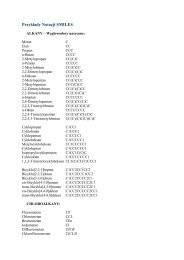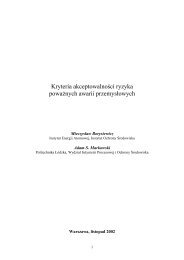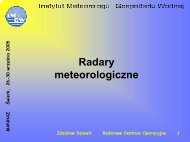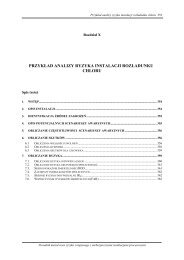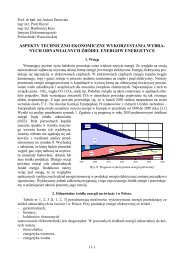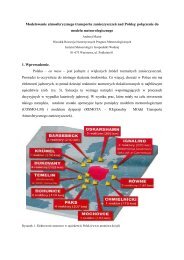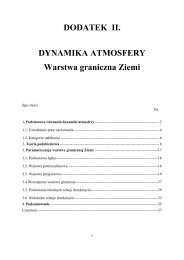Modelling of Pollutant Transport in the Atmosphere - MANHAZ
Modelling of Pollutant Transport in the Atmosphere - MANHAZ
Modelling of Pollutant Transport in the Atmosphere - MANHAZ
You also want an ePaper? Increase the reach of your titles
YUMPU automatically turns print PDFs into web optimized ePapers that Google loves.
Due to <strong>the</strong> rotation <strong>of</strong> <strong>the</strong> earth, <strong>the</strong> geostrophic balanced w<strong>in</strong>ds tend to<br />
flow parallel (and not across - as one would <strong>in</strong>tuitively th<strong>in</strong>k) <strong>the</strong> isobars (i.e.,<br />
<strong>the</strong> l<strong>in</strong>es <strong>of</strong> equal pressure). This happens because on <strong>the</strong> regional or "synoptic<br />
scale" (i.e., on horizontal scales <strong>of</strong> <strong>the</strong> order <strong>of</strong> ~1000 km or more) <strong>the</strong>re is a<br />
balance on air movement between <strong>the</strong> pressure gradient force, and <strong>the</strong> Coriolis<br />
force, <strong>the</strong> latter be<strong>in</strong>g associated with <strong>the</strong> rotation-rate <strong>of</strong> <strong>the</strong> Earth. O<strong>the</strong>r<br />
forces, such as <strong>the</strong> sheer<strong>in</strong>g stress caused by <strong>the</strong> drag <strong>of</strong> <strong>the</strong> ground, and air<br />
channel<strong>in</strong>g through valleys and over passes, will result <strong>in</strong> strong local w<strong>in</strong>d<br />
deviations from <strong>the</strong> regional geostrophic w<strong>in</strong>d fields. On <strong>the</strong> local scale, say out<br />
to distances with<strong>in</strong> 10-20 km from <strong>the</strong> release po<strong>in</strong>t, effects <strong>of</strong> <strong>the</strong> underly<strong>in</strong>g<br />
surface with its topographical features also tends to be important for <strong>the</strong> w<strong>in</strong>d<br />
speed and direction, each tree, house and hill exerts drag on <strong>the</strong> air, and heat<br />
and moisture pr<strong>of</strong>iles <strong>of</strong> <strong>the</strong> air becomes important.<br />
The vertical w<strong>in</strong>d pr<strong>of</strong>ile. The "free" geostrophic w<strong>in</strong>d mentioned above<br />
prevails above <strong>the</strong> ABL, i.e. above say above ~1 km up <strong>in</strong> <strong>the</strong> atmosphere. It<br />
flows parallel to <strong>the</strong> isobars. Closer to <strong>the</strong> Earth's surface, that is, with<strong>in</strong> <strong>the</strong><br />
strong turbulent ABL, <strong>the</strong> w<strong>in</strong>d speed is gradually decreas<strong>in</strong>g, due to <strong>the</strong><br />
friction with <strong>the</strong> rough ground surface. Near <strong>the</strong> surface, houses, trees, hills<br />
and forest perturb <strong>the</strong> velocity pr<strong>of</strong>ile.<br />
The local turbulence level depends on <strong>the</strong> local "atmospheric stability" which <strong>in</strong><br />
turn is characterized by 1) <strong>the</strong> magnitude <strong>of</strong> <strong>the</strong> w<strong>in</strong>d speed 2) <strong>the</strong> surface<br />
roughness, and 3) <strong>the</strong> vertical temperature pr<strong>of</strong>ile.<br />
F<strong>in</strong>ally, because <strong>of</strong> <strong>the</strong> drag forces that exercises on air that flows near <strong>the</strong><br />
Earth's' surface, <strong>the</strong> w<strong>in</strong>d direction is <strong>of</strong>ten turned some 20 degrees counterclockwise<br />
(towards <strong>the</strong> centre <strong>of</strong> <strong>the</strong> low pressure) relative to <strong>the</strong> direction <strong>of</strong><br />
<strong>the</strong> geostrophic "free" w<strong>in</strong>ds that blows parallel to <strong>the</strong> isobars near <strong>the</strong> top <strong>of</strong><br />
<strong>the</strong> ABL at ~1 km height. This "veer<strong>in</strong>g <strong>of</strong> <strong>the</strong> w<strong>in</strong>d direction with height" can<br />
easily be observed on a "cumulus cloudy" day, where <strong>the</strong> w<strong>in</strong>d direction near <strong>the</strong><br />
top <strong>of</strong> <strong>the</strong> ABL is marked by <strong>the</strong> motion <strong>of</strong> <strong>the</strong> cumulus clouds, while <strong>the</strong> near<br />
ground w<strong>in</strong>d direction can be read from a nearby flag, a w<strong>in</strong>d turb<strong>in</strong>e or from a<br />
smoke plume.<br />
6



